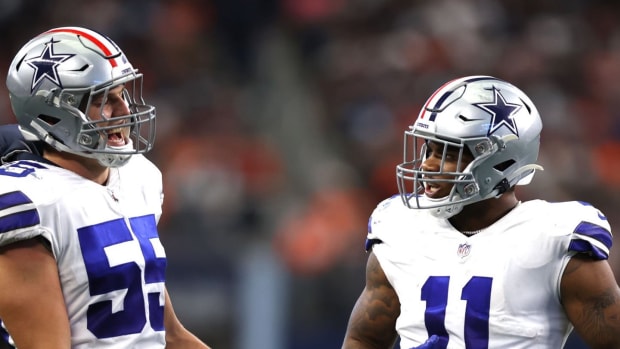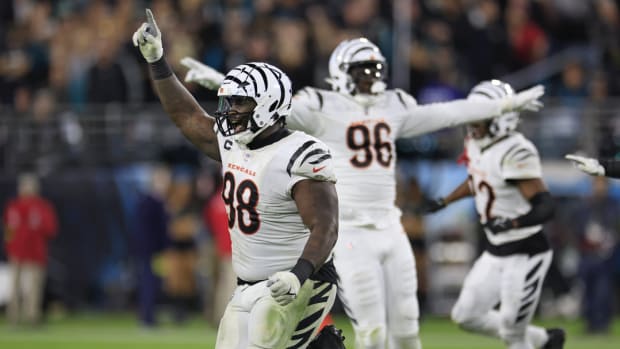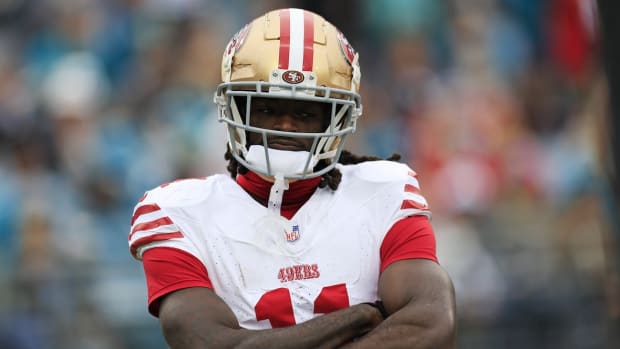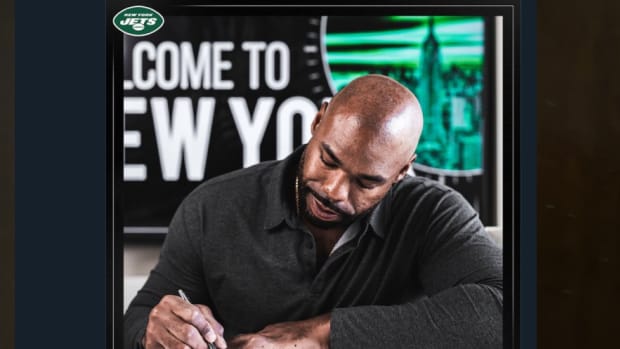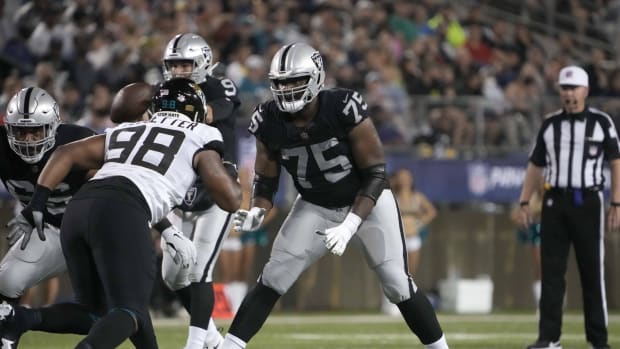On Risk, Old Rules and How Kirk Cousins Laid The Groundwork To Forever Change NFL Contracts
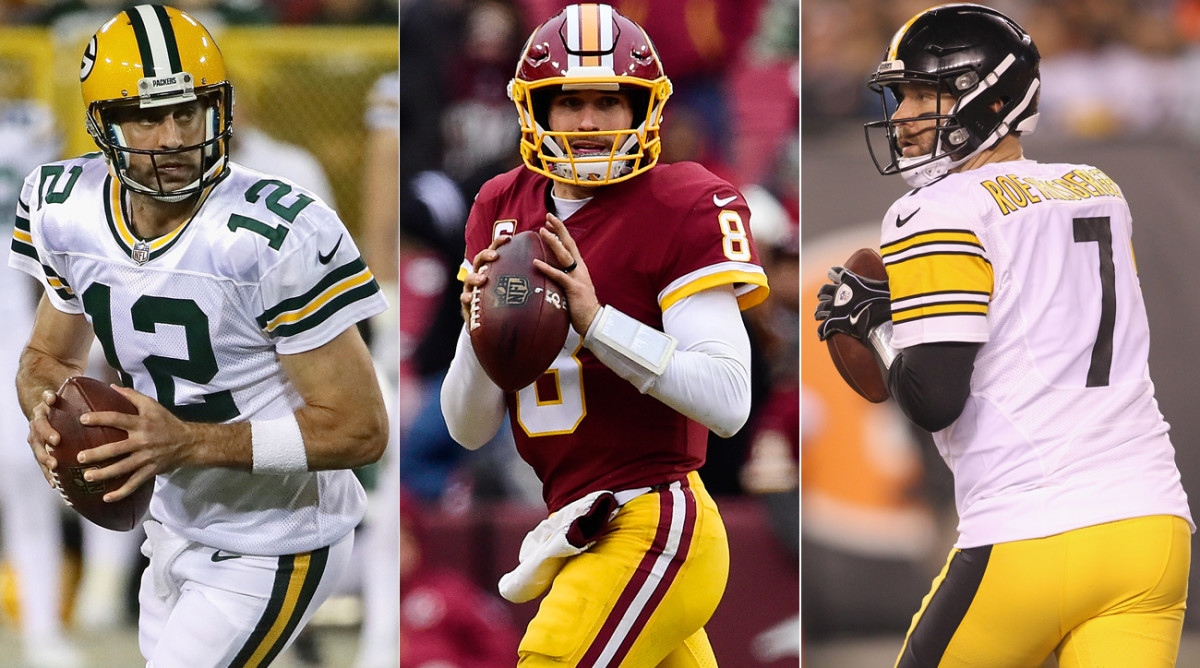
Credit to Kirk Cousins. It took stomach to pull off what he did. Two years ago, when his agent, Mike McCartney, first proposed a fully guaranteed three-year deal to the Redskins, he might as well have been asking the team for the deed to FedEx Field.
It’s now March 2018. And McCartney and Cousins are hours away from pulling it off.
Not everyone would have been cool with turning down a shot at long-term stability as a starting quarterback, and choosing to play out a season on the franchise tag with a multiyear offer on the table. Even fewer guys, given the injury rate in the league, would have been willing to do it twice. Cousins was.
And this afternoon in Eagan, Minn., he’ll get his reward—a groundbreaking, fully guaranteed, three-year, $84 million deal as the new quarterback of the Vikings. This after making just under $3 million his first four years in the league. This after taking home $43.9 million on tags the past two years. This, more than anything else, after listening to his agent and making a massive wager on himself.
“He shifted a little risk on to himself and said, ‘I believe in myself, and I’ll go do it,’” NFLPA president Eric Winston said Wednesday night. “What’s obvious is the blueprint is there. Every player’s got to decide. It comes down to how you want to handle your business. The blueprint is there. Obviously, for a quarterback, it’s there. And then it’s a matter of what you want to take.”
Could this lead to bigger change? That much will be up to Atlanta’s Matt Ryan, Green Bay’s Aaron Rodgers, New England’s Tom Brady and Pittsburgh’s Ben Roethlisberger—four quarterbacks clearly in line for new deals this offseason who will determine whether Cousins is an outlier or a trend-setter.
If they do traditional deals, it’s hard to see major change coming about. If they follow the Cousins blueprint, and hold the line, the ground may just move on the way NFL players are paid.
NFL Free Agency 2018 Guide and Tracker: Suh to the Rams
In this week’s Game Plan, we’re going to take you through how the Rams are pushing change after a year of progress; show you why Patrick Mahomes is the right kind of guy in Kansas City; explain the mega-deals for new Giants tackle Nate Solder and Jaguars guard Andrew Norwell; illustrate how the Jets were prepared to lose out on Cousins; and give you the lesson Tyrann Mathieu can teach all young players.
But we start with the story of the offseason, and that’s Kirk Cousins’ landing spot. It is right where the season ended in Super Bowl LII, and with the team that was just one win from becoming the first to host the big game. And we’re going to go bigger picture here, because the deal Cousins will sign could wind up being about much more than how far he can take the Vikings in 2018.
Where things go from here depends on the handful of superstar quarterbacks next in line for new contracts, and what they can do to tear down an old rule that’s been on the books forever. This rule has served as a big-time roadblock in football players’ fight for guaranteed money.
The NFL’s funding rule was put on the books around the AFL-NFL merger, before the big national TV deals, and was meant to ensure that players would get the money they were owed. At a time when some franchises were on the financial ropes, the provision came in stipulating that every fully guaranteed dollar owed to a player, but not yet paid to him, had to be funded to a league-run escrow account.
Back then, it made sense. Guys had reason to worry about their checks clearing. But as the league’s earning power has grown, the rule’s usefulness has changed. Now, it’s deployed by teams almost exclusively as a shield. Clubs will tell players they can’t afford to guarantee deals because funding them creates cashflow issues. And that much is no secret.
“The funding rule is archaic,” McCartney said on Wednesday night. “It doesn’t belong in the NFL. And the sooner we can get it eradicated, the better.”
McCartney and Cousins have done their part. The rest? Follow us here …
• Ryan is entering the final year of his contract, while Brady, Rodgers and Roethlisberger all have two years left. Each could get an extension this offseason, and each is more accomplished than Cousins.
• Say Ryan goes first. And say Ryan gets a fully guaranteed, three-year, $90 million deal. Then the pressure will be on Rodgers, Brady and Roethlisberger to follow suit.
• If all five were to get fully guaranteed deals, then that’s five owners cutting massive checks to follow a rule that lacks any functional reason.
• And then, a rule that’s always been bad for players is suddenly bad for owners.
Why Kirk Cousins Can Succeed With the Vikings
The funding rule isn’t collectively bargained, which means the owners could pull it off the books tomorrow if they wanted. It’s been good to them, so they haven’t. And so it’s up to individual players—quarterbacks, in particular—to change that.
“For a lot of years, we took their word for it, they won’t do [fully guaranteed deals],” said Winston. “And Kirk proved they will do it. They want to win. They could come back tomorrow and say, ‘We’re gonna get rid of it.’ And they get rid of it, and that’s it.”
The reality is that if players want the fully guaranteed contracts that their peers in baseball and basketball have, this is how it needs to happen. There isn’t a collective bargaining agreement in a major sports league in North America that either requires or prohibits guaranteed contracts. It has to happen through individual negotiations.
That means taking a stand in situations like this, as Cousin has done the past two years.
Now, the ball is Ryan’s court. And Rodgers’ court. And Brady’s court. And Roethlisberger’s court.
We’ll see how hard they swing back. Plenty of their brethren will be watching.
FIRST AND 10
1. Biggest question on Kirk Cousins’ fit in Minnesota? His ability to play off-schedule. One reason why Case Keenum was right for the Vikings last year is because, behind a rebuilt offensive line, he was so good at improvising. Cousins, on the other hand, has always been a quarterback who can excel when everything’s right around him, and he certainly benefited from playing behind one of the NFL’s best lines in 2015 and ’16. (And he suffered when the Washington line got hit with injuries last year.) I love the Cousins signing for Minnesota. But this is an interesting element to watch that more than one coach raised to me this week.
2. Given what bridge quarterbacks are going for—they’re all well into eight figures APY—Denver had a relatively valuable commodity in Trevor Siemian to peddle to teams the past few days. The former seventh-round pick has 24 NFL starts under his belt and is on the books for less than $2 million for 2018, creating savings that could mean, for another team, keeping a middling player on the roster that it may otherwise have unable to afford. That’s why it was worth it to the Vikings to flip a couple picks (a 2018 seventh-rounder comes with Siemian and a 2019 fifth-rounder comes back) to get him.
3. Meanwhile, that clears the decks for the Broncos to add another first-round quarterback to the roster. Keenum, on a two-year, $36 million deal, will be the starter. Paxton Lynch will be one backup. The other could well be the fifth overall pick of 2018. At the very least, Denver’s doing all its homework. John Elway, personnel chief MattRussell and coach Vance Joseph were at Oklahoma on Wednesday, will be at UCLA on Thursday and have plans to go to USC and Wyoming, too, with more planned tire-kicking on Josh Rosen, Sam Darnold, Josh Allen and Baker Mayfield.
4. Joe Thomas retired yesterday, and one thing unfortunate about it is that he’ll go out more than a year separated from his last win. And that raises the amazing way in which he’s handled all of that—all the losing hasn’t made his relationships inside the building go sideways. That’s something that his coaches, especially the ones he worked with in his later years, really appreciated. “Very easily he could’ve been standoffish with me, and ‘whatever, this is my however-many-th head coach,’ ” ex-Browns coach Mike Pettine, now the Packers defensive coordinator, told me a little while back. “But he always had a positive attitude, and was always there willing to help. … For a guy that could be scarred for the amount time he’d been with a lack of team success, you’d never know it.” Thomas’s draft classmate Brady Quinn on Wednesday called Thomas the “best player I ever played with, and somehow he’s an even better person.” And the fact that his attitude never really went south as the franchise did is proof of it.
Orlando Brown Runs (and Jumps, and Lifts) Away From His Combine Nightmare
5. While we're there, the last thing that Browns coach Hue Jackson said to his players before they broke for the offseason: “This is the last time. I don’t want you ever to feel like this again.” He knew his players were worn out by 1-31, and he knew results would eventually have to replace all the promises of brighter days ahead. That’s one reason why the trades for Tyrod Taylor, Jarvis Landry and Damarious Randall were so significant. They should buoy the mindset of a young team that’s been through a lot.
6. The 2016 Eagles’/2017 Bears’ over-investment-at-quarterback model we’ve discussed here is exactly what we’re seeing in Cleveland (Taylor), New York (Josh McCown/Teddy Bridgewater), Denver (Keenum) and Arizona (Sam Bradford/Mike Glennon). Each team dropped money well into eight figures on veteran quarterbacks with eyes firmly trained on the college class coming.
7. The big shocker for me this week? Receiver money. New Chief Sammy Watkins got a three-year, $48 million deal with $34 million in the first two years. And new Bear Allen Robinson got $42 million over three. Both guys were damaged goods, too. Watkins had foot issues and only caught 39 balls in Sean McVay’s offense last year. Robinson is coming off a torn ACL. In the past, guys like that would have to do one-year, make-good deals like Jeremy Maclin did in 2014 and AlshonJeffery did last year. Not anymore, evidently.
8. Crazy fact: Ndamukong Suh played three years on the six-year, $120 million deal he signed in 2015, and made almost $60 million. He was cut Wednesday. And amazingly enough, based on average-per-year, that deal is still the biggest in NFL history for a non-quarterback. Which is bananas. Rams DT Aaron Donald and Raiders DE Khalil Mack figure to be the next guys capable of challenging Suh’s numbers throne.
9. Dion Lewis, Malcolm Butler and Nate Solder are gone, and the Patriots are still waiting on Rob Gronkowski to make a final call on whether or not he’ll play in 2018. Gronkowski’s made reference to money on Twitter of late, and the fact that the Eagles’ third-string tight end, Trey Burton, got $8 million per in Chicago probably isn’t making the Patriots superstar any more comfortable with playing on his current $9 million-a-year contract. Do the Patriots sweeten his deal? Do they explore his trade value? Do they set a deadline? It’s a tricky situation for the team.
10. Thursday’s a big day for UCLA’s Josh Rosen. He’s the most natural passer of all the draft-eligible quarterbacks, but scouts were shocked by how uneven he looked spinning it in Indy. Coaches told me it seemed like the ball wasn’t coming out of his hand right. So it’ll be important for him to show that it was an aberration, and that he is, indeed, the guy they scouted the last few years as a quarterback who looked like he was born to throw a football.
FOUR DOWNS
1. Rams flipping the script.All the ideas to be aggressive and make changes and not rest on the 11-5 breakthrough of 2017 looked great on paper to Rams GM Les Snead. But then he actually had to make the walk out to the team’s practice fields with coach Sean McVay to tell linebacker Alec Ogletree, out doing routine conditioning work a few weeks back, that he was being dealt to the Giants. Separating from 2017 and actually going to 2018 got pretty real.
“You make that 20-yard walk, and it goes through your mind,” Snead said, driving home Wednesday night. “You drafted him, you met his family, you saw his fiancé become his wife, you saw them have their first kid, you saw him become a leader. So over here, you’re the GM trying to make moves to improve the architecture of the team. And you take that walk to communicate it to him, and it’s more about the human being.”
There’s a lot Snead, McVay and everyone in Los Angeles will remember fondly about 2017, but the team’s brass isn’t acting with any trepidation now, hard as it might be. The commitment was made after the season to sink resources into renovating the defense this offseason the way the Rams had with the offense and the coaching staff a year ago. And Snead knew exactly what coordinator Wade Phillips wanted—studs to man the perimeter of the secondary and his 3-4 front.
Work on the former started with a call from Chiefs GM Brett Veach on a Sunday in February, a call that Snead missed during a workout. When Snead called back on his ride home, Veach told Snead that Marcus Peters was available. A little over a week later, while Snead was on vacation in Hawaii, the deal was consummated. And that led to the Rams’ interest in Aqib Talib, who would provide a veteran bookend, and by then was known to be available. Of course, it was the $11 million Talib was due that necessitated the trade of Ogletree, who joined Robert Quinn and Trumaine Johnson as key elements of the 2017 defense on their way out. That, in turn, leaves work to be done in a front seven that’s fronted by reigning Defensive Player of the Year Aaron Donald. But the offseason’s not over yet, and as Snead sees the difficult steps the team’s taken this winter should prove significant in the fall.
“The defensive backfield in Wade’s scheme, those are very important positions,” Snead says. “We like our safeties, we like our corners. We have more to do. But we already have a good attacking offense. And we wanna get that defense suffocating.” Standing pat wasn’t going to get them there.
Free Agency Free-For-All: Thoughts On All The Deals Done Before The NFL Year Opens
2. Offensive line market booming. When I was doing last week’s Game Plan, I asked around for things that stuck out about the free-agent class, and there was one particular theme that came up a couple times. “There are limited options at offensive tackle in free agency and the draft,” said one AFC GM, echoing others. “Globally, it’s not a year to be looking for one. For teams needing tackles, it’s a tough year to solve that issue.”
The truth is, this is more of a trend than a one-year thing. Last year may have been even worse. Last spring, we told you about the NFL’s developmental problem up front. College spread offenses have made it harder to project guys to the pros, and the practice rules have made it tough to develop them. If a guy’s not starting? Once camp breaks, he really has the 14 prescribed padded practices during the season—and that’s it—to get in anything close to game-like work. It used to be that taking a left tackle, like a Tony Boselli or Jonathan Ogden, at the top of the draft was as close to a sure thing as you could get in the NFL. These days? Greg Robinson and Luke Joeckel are two good examples of how much harder it’s become, which only juices the value of proven commodities.
So it should be no surprise that we’re coming out of the opening of free agency with a new highest paid tackle (Giants’ Nate Solder) and guard (Jacksonville’s Andrew Norwell). Especially since the same sort of thing happened last year with players like Russell Okung, Kevin Zeitler and Riley Reiff, all of who made more than $11 million per year on new deals done then, which is why the Bengals felt like they got a bargain in trading for ex-Bills LT Cordy Glenn, whose contract has $30 million over three years remaining.
If there’s good news here, it’s that the draft should be a little better this year. Last year, no offensive linemen went in the first 15 picks—Denver’s Garrett Bolles was the first one off the board, at 20—for the first time in the event’s history. This year, Notre Dame G Quenton Nelson is a lock to go considerably higher than Bolles did, and his teammate Mike McGlinchey and Texas’ Connor Williams give teams two first-round options at tackle. And yet, beyond that, there isn’t a ton of depth. And it’s not like there’s some gigantic bumper crop on the horizon. For now, for teams with problems in this area, the answer seems to be to pay through the nose for a player someone else found a way to develop.
3. Jets’ flight plan. The Jets absolutely wanted Cousins, and probably worse than anyone else did. But if you go back a few months, you’ll see that he wasn’t initially Plan A for the team. A few months back, the idea for 2017 was to strip down the team, rely on young guys, and get a Top 2 or 3 pick to spend on a quarterback. And this wasn’t just on paper, either. At the urging of ownership, the Jets’ personnel department sunk an absolute ton of resources into kicking the tires on all the college quarterbacks last fall. New York had a scout at just about every UCLA, USC, Wyoming, Oklahoma and Louisville game in 2017, and did all the background you can imagine on Josh Rosen, Sam Darnold, Josh Allen, Baker Mayfield and Lamar Jackson.
So what changed? Two things. First, the Jets’ young core, particularly on defense, got feisty early, and a three-game winning at the September/October turn doomed the idea that the team would be able to keep up with the likes of Cleveland and the Giants in the race for the first pick. Second, quarterbacks coach Jeremy Bates impressed enough to earn a promotion to coordinator just as a signal-caller proven in his system, Cousins, was set to come free. Remember, Bates is a disciple of Mike Shanahan, just as Cousins and his two favorite play-callers (Kyle Shanahan and Sean McVay) are. So add the early-season surge to Bates’ rise, and you had a team with the sixth pick that could try and get a proven quarterback, which would free it up to use its draft capital to build on last year’s transformational offseason. That’s how they drew it up, anyway.
Now? Well, they move forward with the information they need—and I expect we’ll see Top 30 visits and on-campus workouts with the top quarterbacks here, too—on the quarterbacks, and less flexibility with their picks, particularly if they need to trade up. It’s not ideal, and it didn’t feel good for anyone there this week. But with Josh McCown and Teddy Bridgewater in the fold as “for now” answers, they can move forward with what they’d set out to do in the first place, and that’s take one high in April.
4. Reasons to buy in on Pat Mahomes. The Chiefs bought their new triggerman a shiny new weapon Wednesday in breaking the bank for Sammy Watkins ($34 million over the next two years, $30 million of which is fully guaranteed). And in doing so you can see the vision for where the K.C. offense is going. Running downfield with Watkins, Tyreek Hill and Travis Kelce won’t be easy for any defense, and Patrick Mahomes’ howitzer of a right arm makes the threat of game-changing plays real. This, of course, is all part of why Kansas City sold off this year’s first-round pick to move up 15 spots last April and get the then-21-year-old.
The other part? The Chiefs believed they were getting a guy who was a natural leader, and had an easy command as a lead dog. We’ll see how the first part plays out. As for the second part, there’s already pretty good evidence that the Chiefs have confirmation.
There were points during the 2017 season when Mahomes could’ve made things uncomfortable on Alex Smith. Kansas City did go through a 1-6 stretch, and the rookie’s presence on the roster, combined with the team’s investment in him, gave everyone an easy, “in case of emergency, break glass” solution to go to as a team that was aging in spots struggled to regain its stride. Instead, Mahomes went in the other direction all together. The rookie would get extra work, as young players often do, after practice to put physical reps to everything he was studying in acclimating to the pro game. But he made a point of doing it with backup or practice-squad receivers. Why? Because, as he saw it, the starters were part of Smith’s unit, and he didn’t want to be seen as infringing on Smith’s turf.
It’s a little thing, to be sure. But as the coaches and staff saw it, it was another example of how Mahomes had a good sense for how a team worked, and what being a good teammate meant. Bottom line, it could’ve been awkward between the quarterbacks, and it didn’t end up being like that at all. “He handled that situation better than we could’ve ever predicted,” said one Chiefs staffer. “Kid is a stud in that.”
And so they all have little doubt that when April comes and the offseason program kicks off, Mahomes will be able to smoothly move into a leadership role, even at 22 years old. Because he’s already made something that should’ve been pretty difficult look relatively easy.
LESSON OF THE WEEK
Tyrann Mathieu’s been through a lot in his life, but what Wednesday presented him with something new. When the Cardinals made that call, it was the first time he’d ever been cut from a team. Ever.
“Obviously, I was expecting it,” Mathieu told me a couple hours after getting word from the team. “But when it happened, I was still kind of shocked. I was supposedly one of the best players on my team. Now, I’m cut. It was shocking.”
And therein is a lesson for all players signing deals this week: Check your contract, look for the first out the team has in that deal, and know that no matter how great things may be going now, nothing is guaranteed past that point.
It was just 19 months ago that Mathieu—coming off a Defensive Player of the Year caliber season that ended with a torn ACL—inked a five-year, $62 million deal in Arizona, the kind that has players thinking they’ll finish their career in the place they started it. The contract was trumpeted to carry $40 million in “guarantees.” Mathieu wound up making a little less than $22 million of that.
Truth be told, the reality that his circumstances could change started to hit the 25-year-old Mathieu during the early stages of last season. His rookie year ended with a torn ACL in his left knee, his third season was short-circuited by a torn ACL in his left knee, and a shoulder injury hampered him for much of his fourth season before ending it all together.
Going into Year 5, all the injuries and related rehab had taken their toll. And it was more about his mindset than his body at that point.
“I wasn’t playing well, I didn’t hit the ground running,” he explains. “And so there was noise, chatter about me and about what I can do and whether I was all the way back from the injuries. I’d listen to the radio, look at articles, they’d put that out there. The Cardinals can cut him. I was aware. So I just tried to put myself in a position where people would want me again. I thought I finished the season strong.
“I had a few years where I’d come back from injuries and play at a high level. And to do that over and over, it was poking at my confidence. That held me back, my confidence level down, and keeping me from what I was having to do.”
Eventually, it came back. He wasn’t all the way to where he’d been during his breakout 2015 season, but, “I was on that track, believing in myself, being instinctive, and not worrying about messing up and just playing football.”
And Mathieu thinks now with a full offseason, he’ll get there. That brings us back to his contract, which featured figures that required Arizona to take a leap of faith and ultimately challenged Mathieu’s value.
Arizona’s coaching change didn’t help. Where Bruce Arians’ defensive coordinators—first Todd Bowles and then James Bettcher—called for versatile, interchangeable safeties that could slide to corner, new coach Steve Wilks’ scheme would cast Mathieu in a more traditional safety role. That diminished what he was worth.
So Mathieu says the Cardinals first wanted to shave $5 million off the $11 million he was due in 2018. That was about a week ago. When he said no, Arizona came back and asked if he’d take a $3 million pay cut. And when he rejected that, the writing was on the wall and Mathieu was just waiting for the call that came Wednesday.
What’s next? Well, Mathieu says he’d love to find a football-centric landing spot with strong defensive history. And he says fit will be important.
“It’s not all about money for me,” he says. “I want to go somewhere where I can be completely immersed in football, and it’s not too much about anything but winning. I want to be a part of winning culture, where you feel that all the time. That’s all I want.”
In short, he wants back what he had a couple years ago playing for Arians—a place where he can win and get the most out of his ability. And again, there’s a lesson in there for every player, on how everything can change in the blink of an eye. Mathieu learned it, and he’d be happy to explain it to any younger player.
“I’d tell them, don’t have any regrets, just put your best foot forward,” he said. “And don’t worry about the business of the game, because it can get to you. Just handle what you can handle, don’t set your heart on being with one team, because things can change. I’d tell all those guys to just keep pushing forward.”
And Mathieu can say that now having little choice but to do so himself.
• Question or comment? Email us at talkback@themmqb.com.

































